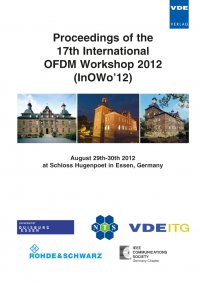Partial Scrambling PAPR Reduction for Multi-Code Vector Coding in Adaptive Modulated MIMO Systems
Konferenz: OFDM 2012 - 17th International OFDM Workshop 2012 (InOWo'12)
29.08.2012-30.08.2012 in Essen, Germany
Tagungsband: OFDM 2012
Seiten: 7Sprache: EnglischTyp: PDF
Persönliche VDE-Mitglieder erhalten auf diesen Artikel 10% Rabatt
Autoren:
Muta, Osamu (Center for Japan-Egypt Cooperation in Science and Technology, Kyushu University, Fukuoka, Japan)
Inhalt:
Multi-Input Multi-Output (MIMO) Vector coding (VC) transmission with adaptive modulation is an effective technique to enhance transmission performance in frequency selective wireless channels. The VC is a kind of code-division multiplexing (CDM) by which eigenvectors of channel autocorrelation matrix are used as spreading code. A major disadvantage of the VC is that the transmit signal exhibits high peak-to average power ratio (PAPR), which causes nonlinear distortion and/or power efficiency degradation at a power amplifier, similarly to OFDM and CDM systems. As a solution to this problem, selected mapping (SLM) PAPR reduction techniques have been studied. This paper presents a partial scrambling SLM PAPR reduction method for multi-code VC transmission in adaptive modulated MIMO systems. In this method, PAPR of the transmit signal is reduced to scramble bit sequence mapped on limited number of code vectors in VC systems. In addition, the maximum amplitude of transmit signal in each transmission block is reduced only when the maximum peak amplitude exceeds a given threshold value. Simulation results clarify that the partial scrambling method achieves better average throughput performance than the conventional method, although almost identical PAPR reduction performance is obtained for MIMO VC systems in an attenuated six-path Rayleigh fading condition. Index Terms — Vector coding, Peak-to-average power ratio (PAPR), PAPR reduction, MIMO


